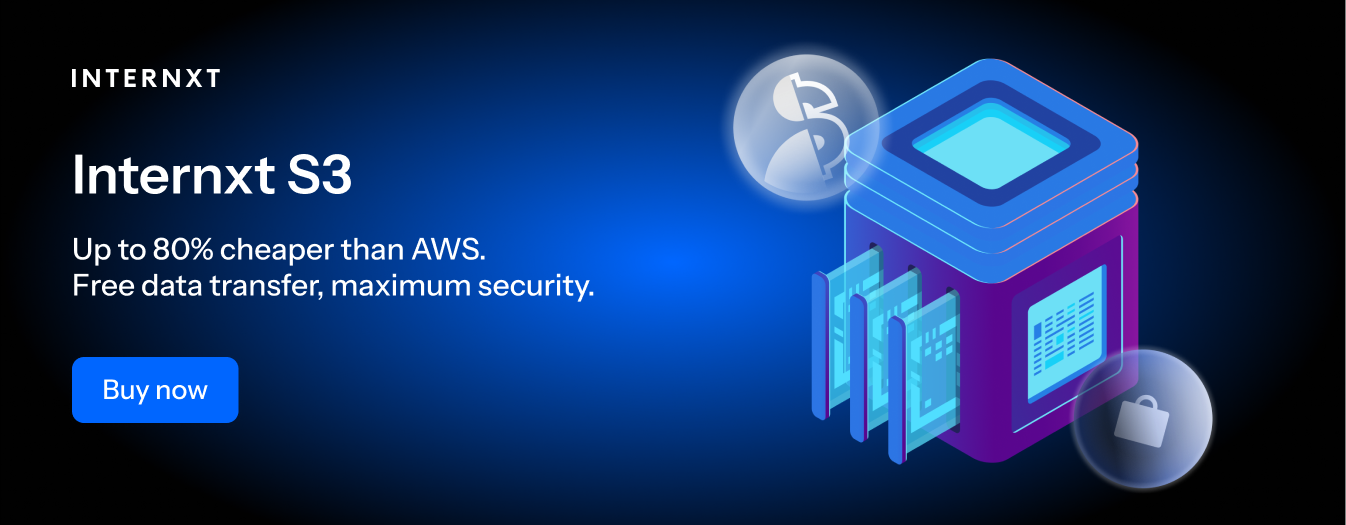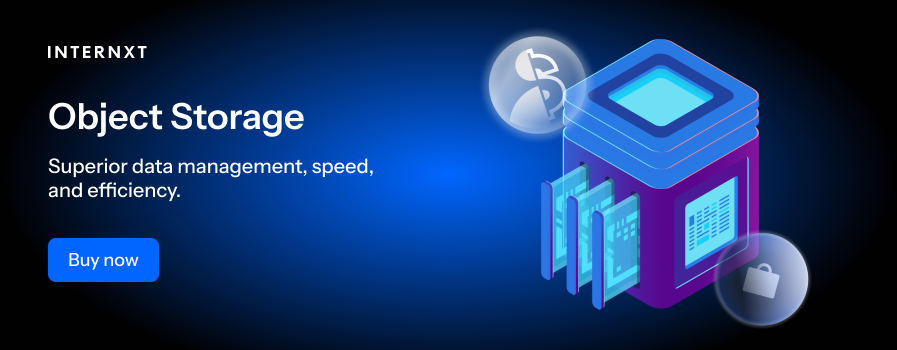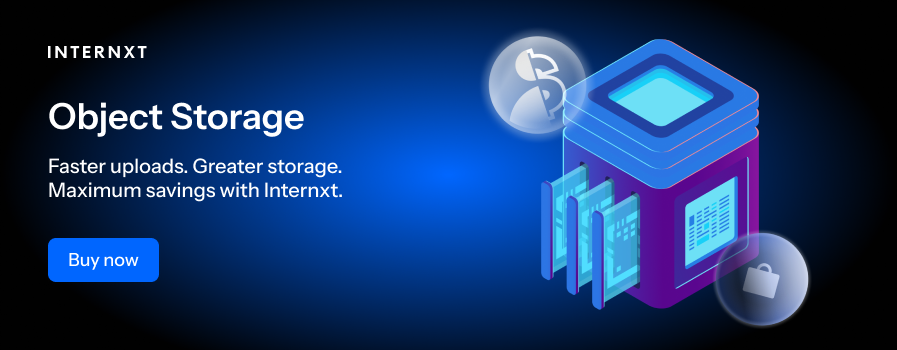What Is Hot Cloud Storage and Is It The Right Solution for You?

Feeling hot hot hot?
If you’re interested in knowing what is hot cloud storage, you’re in the right place. Hot or cold storage are a common way to describe different kinds of storage, but what do they mean?
Hot or cold storage describes how easily or quickly you can access your data, hot being the quickest, and cold being the slowest, and is for data you rarely need.
Today, we will explain what is hot cloud storage, how it compares to cold storage, how they are used, who offers these services, and how Internxt S3 object storage offers a fixed fee of €7/TB/month to help meet your hot cloud storage needs.
Table of contents
- What is hot cloud storage?
- What is cold storage?
- What are the advantages of hot storage?
- What are the advantages of cold storage?
- What is hot cloud storage used for?
- Hot cloud storage providers
- How to manage hot cloud storage
- Hot or cold storage?
What is hot cloud storage?
Hot cloud storage is a type of cloud storage that you would use when time is of the essence and you want quick and immediate access to critical data. It is an essential tool for industries requiring real-time data processing and rapid response times, including video editing, web content, application development, or analytics tools.
It uses high-performance hardware like SSDs or fast hard drives to ensure quick access times. Because of this speed and availability, hot cloud storage usually costs more than other types, like cold storage, which is meant for infrequent access of files.
Data stored in higher tiers may use solid-state drives (SSDs), which are optimized for lower latency and high transactional rates compared to traditional hard drives.
The hotter the cloud storage, the more advanced the technologies it uses, including SSDs, faster transport protocols, and closer proximity to clients for quick access to data.
In other cases where heavy data use is required, data can be stored on hard disk drives as they can stand the demands of continuous use, unlike SSDs.
The hottest kind of cloud storage may come at additional costs due to the resource-intensive nature of the technology used. Companies like Azure or AWS S3 offer tiered pricing depending on your data storage needs, which can be viewed in our S3 pricing explanation article.
There are also options to buy object storage from cloud storage resellers, and if you buy in bulk at a discounted rate, you can resell it for a profit.

Internxt S3, however, offers 100% hot cloud storage at a fixed rate of €7/TB/month with no data transfer fees so that you can get unlimited cloud storage with no additional costs for rapid access to your business data.
What is cold storage?
Now that we have answered what is hot cloud storage, it’s time to look at the opposite end of the scale to fully understand which kind of storage is best suited for your needs. For this, we will look at cold storage.
Hot cloud storage provides immediate access to urgent data, whereas cold storage is more suited to information that is rarely accessed and isn’t as urgent as hot data. For example, cold storage will store data that remains dormant for months, years, decades, or it can house data that will never be accessed again.
Cold storage is, therefore, better suited for old projects or business records in financial, legal, or HR environments.
Cold cloud storage is more focused on cost-effective data management rather than advanced features such as data manipulation. They are a cheaper alternative to hot storage, but may have higher per-operation expenses.
Plus, if you want to access data from cold storage, it will require patience and planning ahead of time, as the response times are intentionally slower.
Below is a general overview of hot vs cold storage
| Cold | Hot | |
|---|---|---|
| Access Speed | Slow | Fast |
| Access Frequency | Seldom or Never | Frequent |
| Data Volume | Low | High |
| Storage Media | Slower drives, LTO, offline | Faster drives, durable drives, SSDs |
| Cost | Lower | Higher |
What are the advantages of hot storage?
Immediate data access
The primary advantage of hot cloud storage is the rapid and immediate access to data. As the time required to access this data is significantly lower than that required for cold storage, hot cloud storage is a valuable tool for services that need to retrieve data in real time.
Low latency
Another valuable aspect of hot cloud storage is low latency, which offers higher cloud performance. Files can be retrieved much quicker with minimal delays for maximum performance and speed.
Availability & redundancy
Alongside quick access to files, hot storage offers high data availability and redundancy. Files are made available across multiple servers worldwide and can be accessed anytime. Files are backed up to meet GDPR or other compliance requirements for additional data redundancy and disaster recovery.
Internxt S3 is a GDPR cloud object storage solution that backs up your files across multiple European servers for extra redundancy, data recovery, and access.

Scalable
Compared to regular cloud service subscription plans, hot cloud storage can be scaled up or down to meet your storage needs. You can update your plan to meet these needs whenever you face higher storage demands. This can also be done if you no longer need higher storage requirements, and you can downgrade your plan accordingly.
Perfect for active workloads
Finally, hot cloud storage helps teams to regularly access databases or other shared files due to its quick responsiveness and access. Teams can easily manage their data for a more comprehensive data management system.
What are the advantages of cold storage?
Cold cloud storage has advantages; whether it is better than hot cloud storage depends on your storage requirements. Cold storage is a better solution if you want to store data and forget about it until a later time, but you will have to plan this access in advance, as retrieving this data takes longer than hot storage.
Because of this, though, if you later need to retrieve this data, it can take longer and sometimes be more expensive to do so. Nevertheless, it can still be a solution for archiving or backing up data for long periods of time.
What is hot cloud storage used for?
Internxt S3 hot cloud storage can be used for many use cases, but the most popular industrial uses are typically seen in the following industries.
Enterprises
Large businesses can benefit from hot storage to access critical business data instantly and support applications and services that are vital for the company to function.
Technology companies
Tech companies may use hot cloud storage to run and manage SaaS platforms, as running or managing real-time code repositories requires speed and scalability during development and deployment.
Media
Media companies must host, stream, and manage hundreds of thousands of video and audio files. Netflix, for example, uses hot cloud storage to manage videos and ensure quick access to distribute content globally.
E-commerce
E-commerce sites are supported by hot cloud storage to give these companies fast access to databases, customer transactions, and other data required to deliver the best online shopping experience.
Healthcare
Healthcare is consistently the industry most targeted by ransomware attacks, and there are regular news stories about data breaches in hospitals worldwide.
Healthcare needs hot cloud storage to store and access patient data quickly, back up this data, meet compliance, and secure sensitive data with encryption. Internxt S3 storage can provide all of these services.

Hot cloud storage providers
Here are some hot cloud storage providers you can choose from. If you want a pay-as-you-go cloud storage model, then you can continue reading about why Internxt S3 can meet your hot cloud storage needs.
Internxt S3
Internxt S3 is a cloud object storage solution that is part of Internxt’s secure and private cloud storage solutions.
Internxt is based in Europe and follows GDPR compliance, so you can ensure your data and files are handled safely. The object storage is 100% hot, and data is protected from loss or corruption with over 99.99% (119s) of data durability.
All your data is encrypted with the highest standards of encryption, and no matter how much storage you need, or how you manage your data, you only have to pay €7/TB each month, and there are no additional fees for data transfer.
To learn more about this hot cloud storage solution, contact our sales team on our website.
AWS, Azure, Google Cloud
AWS, Azure, and Google Cloud are the most commonly used hot cloud storage solutions, and offer many different options if you need advanced data management features such as integrated AI or file versioning.
There are also cheaper plans available if you need cold storage. Still, for a more detailed overview of these pricing models, you must visit their website and use their cost calculators or speak to a representative to determine which payment model is best for you and your team.
How to manage hot cloud storage
Now we have dived deeper into what is hot cloud storage, its advantages, and how it differs from cold cloud storage. Here are some best practices for managing it securely and efficiently.
Classify and tier your data
When we first answered what hot cloud storage is, we found out that it’s a kind of storage that allows for immediate access to data. When you classify your data, you should put the most essential data you need regular access to at higher tiers for the quickest access and lower priority files at lower tiers or stored with cold storage.
Automate backups
Even though hot cloud storage allows for instant data retrieval, backing up your files is an essential cloud storage practice to prevent data loss. Regularly backing up files can save businesses millions, as it reduce the risk of data loss or ransomware.
Use end-to-end encrypted services
E2E encryption is necessary for all cloud providers to prevent hackers, data leaks, and ransomware. All cloud storage providers must encrypt data at rest and in transit, but you should be 100% sure of a company’s encryption methods before you choose their services.
Internxt S3, for example, uses server-side encryption with customer-provided encryption keys (SSE-C) for maximum data security and privacy.
Hot or cold storage?
As is the case with anything in life, choosing between a hot or cold cloud storage solution will depend on how quickly you need to access your data, your budget, and how much storage you need and potentially scale in the future.
If you want a 100% hot cloud storage solution, Internxt S3 is up to 80% cheaper than AWS, Azure, or Google Cloud. You only pay €7 per month with no additional charges, and you can use it as either hot or cold storage.

Subscribe to our object storage plans today to start managing your data securely, quickly, and efficiently.

